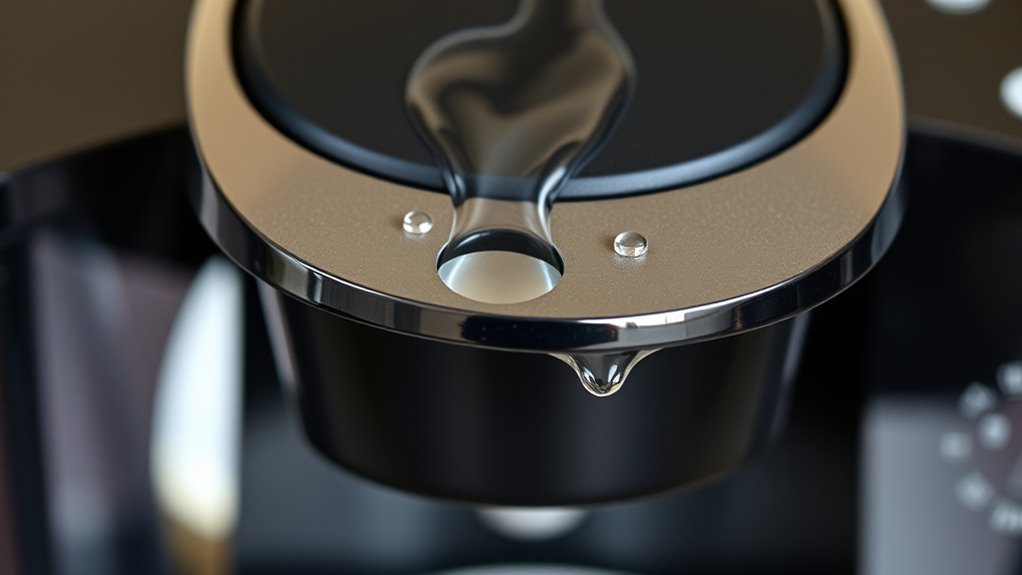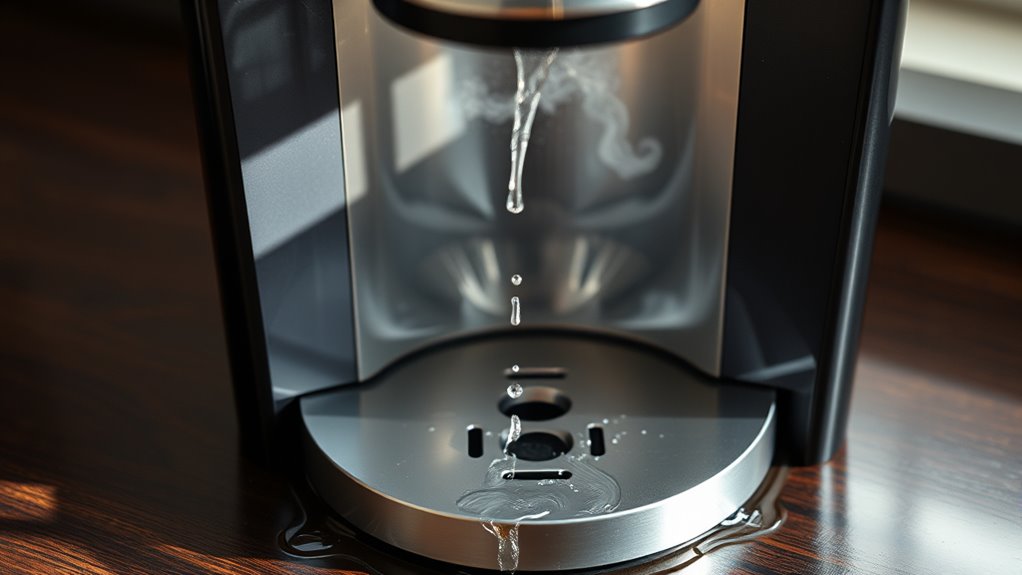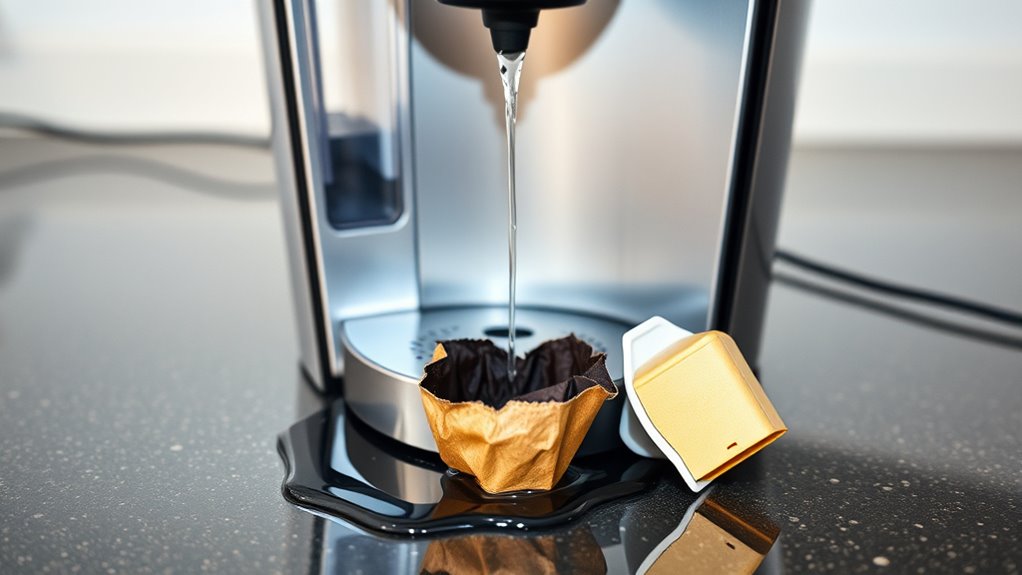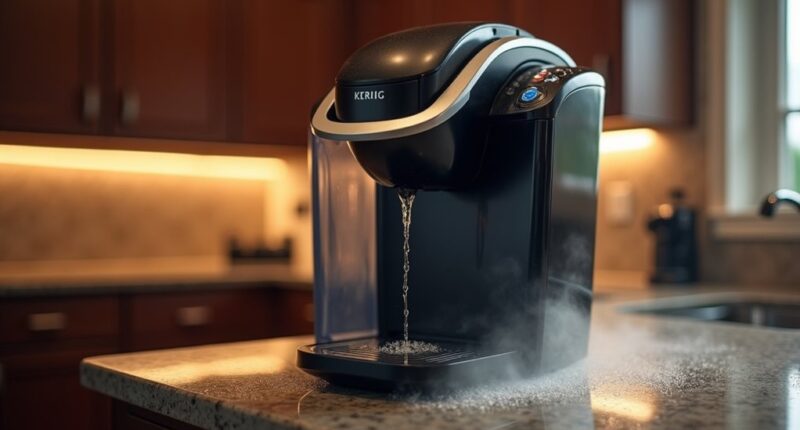Uh-oh! If your Keurig’s leaking water while heating, it could be a few things. Maybe the upper gasket‘s not aligned right, or it’s cracked. Don’t fret—it happens! Internal hoses could be worn out, and those sneaky clogs from coffee grounds or old oils may be causing trouble. Even faulty pods can spill the beans—literally! Keep your coffee machine in tip-top shape, and who knows what tips you’ll find next?
At a Glance
- Inspect the gasket for cracks or misalignment, as these can cause leaks during the heating process.
- Check the internal hoses for wear or damage, which may lead to leaks when hot water is transported.
- Ensure the reservoir is free of cracks and that o-rings are in good condition to prevent water leakage.
- Clean any clogs in the K-cup area or needles, as debris can obstruct proper sealing and lead to leaks.
- Verify that the K-Cups are not damaged or misaligned, as this can cause water to leak during the brewing process.
Causes of Upper Gasket and Seal Failure

Have you ever noticed that your trusty Keurig is springing leaks like a garden hose with a hole? It’s a real bummer!
Gasket alignment issues and material degradation can cause those pesky leaks. If the gasket isn’t properly aligned, water will escape like a coffee thief!
Plus, over time, the silicone can wear out, losing its sealing power. And let’s not forget about those sneaky foreign objects that love to mess things up.
Silicone gaskets can wear out over time, and pesky foreign objects might just be the culprits behind those leaks!
Keeping your machine clean and checking K-Cups helps, but if your gasket’s cracked, it’s time for a replacement. No one wants a coffee disaster, right?
To prevent future issues, ensure that you are using the best tasting ground coffee that doesn’t leave residue in your machine.
Internal Hose and Valve Damage
If you’ve ever felt a sudden splash while enjoying your morning brew, it might be time to pay attention to your Keurig’s internal hoses and valves.
A quick hose inspection could save you from a soggy surprise! Those hoses transport hot water and can wear out over time. Look for cracks or signs of wear; a weak hose can cause leaks.
Also, check the valve integrity—if it’s corroded or clogged, your coffee mightn’t make it to your cup. Additionally, ensuring your coffee maker has the best coffee maker with grinder can enhance your brewing experience and potentially minimize issues like leaks.
Clogging and Debris Obstruction

While you’re sipping that delightful cup of coffee, it’s easy to forget about the hidden battles happening inside your Keurig. Clogs can sneak up on you, thanks to coffee grounds and old oils building up.
You might notice some annoying clogging effects, like weak brews or strange leaks. To keep your machine happy, follow these maintenance tips: clean those needles and K-cup areas regularly, and don’t skip descaling. Regular cleaning with vinegar cleaning tips can help prevent such issues and extend the life of your machine.
It’s a little like giving your Keurig a spa day! Trust me, your coffee will thank you, and you’ll be back to enjoying those perfect cups in no time. Cheers!
Reservoir and Base Seal Issues
After you’ve tackled those pesky clogs and debris, it’s time to turn your attention to another sneaky culprit behind those annoying leaks: the reservoir and base seals.
Trust me, cracks in the reservoir or worn-out o-rings can be a real headache. So, don’t skip your reservoir maintenance—regular checks can save you from a mini waterfall!
If you find damage, don’t sweat it; seal replacement is easy-peasy. Just make sure your new parts fit your model.
Keeping an eye on those seals means more coffee time and less mess. Additionally, using a burr grinder can enhance your coffee experience by ensuring a consistent grind, which is crucial for optimal flavor extraction. Let’s keep your Keurig happy and your kitchen dry!
Faulty Pods and Pod-Related Leaks

When your Keurig starts leaking, it can feel like a mini coffee disaster, and one of the sneakiest culprits might just be those faulty pods you’re using.
Trust me, it’s not just bad luck; it’s all about pod integrity!
- Damaged K-Cups can rupture and create a watery mess.
- Reusable filters, if filled wrong, can let grounds escape, causing clogs.
- Misaligned pods lead to leaks around the holder.
Additionally, using a reusable K Cup can help prevent these issues by ensuring a better fit and reducing waste.





